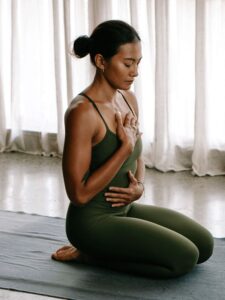In the hustle and bustle of modern life, learning a controlled breathing skill is a necessity. This simple technique is applicable to anyone who faces stress, wants better focus or seeks calm in their daily life. In short everyone. It is a life saver in it’s own right and supports your overall health.
Controlled breathing originated from practices in yoga and pranayama, which are ancient Indian breath control techniques used for meditation, focus, and calming the mind.
The technique was adopted and popularized by the
military and high-performance training, especially in the U.S. Navy SEALs who called it combat breathing.
Box breathing or Square breathing is the technique they use within this practice as a practical way to manage stress, sharpen focus and maintain steady performance under pressure.
It’s also used in stress management practices.
Box Breathing Technique (4-4-4-4 method)
It is also known as Four-square breathing because of the 4 equal parts: inhale, hold, exhale, hold. Equal breathing is another common term; though this can also mean any breathing practice where inhale and exhale are the same length.
Why Should You Learn a Controlled Breathing Technique?
- Calms the nervous system quickly.
Box breathing slows down your heart rate and signals your body to relax. Picture yourself getting late in heavy traffic and feeling your stress rising, a few rounds of box breathing can stop you from reacting in frustration.It’s also useful when handling work related pressure or after receiving upsetting news. Taking two minutes to breathe in this structured way can help your body shift out of fight or flight mode to a calm state. - Builds Emotional Control.
When emotions run high whether it’s anger, anxiety, or even excitement, our breathing tends to become shallow and erratic. Box breathing steadies your breath during tense moments which in turn steadies your mind, making it easier to stay calm in arguments or high-pressure situations.
For example: If you’re about to have a tough conversation with a customer or a loved one, practicing a few rounds beforehand can help you respond calmly instead of reacting impulsively. Athletes and performers often use this breathing technique before going on stage or starting a game to keep nerves in check and maintain composure. - Helps you refocus.
Our minds scatter easily with constant notifications and multitasking. Imagine you are preparing for a business presentation or pitching to investors but you feel overwhelmed.In such a scenario pausing for four cycles of box breathing can clear the mental clutter so you can focus better. Students may also use this technique as a reset during study sessions when their concentration goes down.
Deliberate breathing comes in handy to recharge when retaking a task after a failed attempt. - Improves sleep and relaxation.
Box breathing can be used as a wind-down technique. Doing a few minutes before bed can quiet racing thoughts and relax your body, making it easier to fall asleep. Even during the day, it can serve as a reset button especially when you feel mentally drained, giving you the same refreshed feeling as a short nap without actually taking that siesta. - Can be done anywhere, even in public.
The beauty of this technique is that it doesn’t need a yoga mat, quiet room or special equipment. You can practice it discreetly while waiting in line at the supermarket, sitting on a bus or even before a meeting starts. Nobody around you needs to know, you simply pause and breath in a measured way.
How to Calm Your Mind Through Box Breathing.
Inhale (Breath In) for 4 seconds.
Hold your breath for 4 seconds.
Exhale (Breath Out) for 4 seconds.
Hold your breath again for 4 seconds.
Repeat for 3 to 4 rounds ;takes under 1 minute.
In box breathing, you can exhale through either the mouth or nose, depending on the setting and your comfort.
Nose exhale: Quieter, more discreet . It’s ideal for public or calm settings.
Mouth exhale: Helps release tension more noticeably , because it’s slow and controlled . It’s better for deep relaxation or when alone
Always keep the exhale smooth and controlled, that’s key for triggering a relaxation response.
Why you should Ideally inhale(Breath in) through the Nose.
- It filters and humidifies air, which helps your lungs absorb oxygen more easily while staying protected from irritation and infection.
- Activates the diaphragm for deeper, calmer breathing.
- Helps regulate airflow therefore less likely to hyperventilate, that is ,breathing too fast or too deeply.
- Obviously , it’s more discreet for public or silent use.
🔃 Summary:
Inhale: Nose
Hold: After inhale
Exhale: Nose (or mouth if in private)
Hold: After exhale.
Repeat as many cycles as you need. So a typical silent box breath is all through the nose; inhale, hold, exhale, hold.
🔄 Duration for Recommended Cycles
Quick calm reset: 3 to 4 cycles approximately 1 to 2 minutes.
Moderate anxiety relief: 5 to 6 cycles of 3-4 minutes
Deep relaxation: 8-10 cycles of 5-7 minutes
Daily practice(as a habit): 4 to 10 cycles of 3 to 7 minutes daily.
🎯 Key Tip
Even 1 to 2 cycles can help if done mindfully especially before:
- Public speaking.
- Sleep
- Stressful meetings
- Medical procedures
The Ideal Positions for Box Breathing:
It’s the one that allows your body to be relaxed yet upright, so your diaphragm can function properly and your mind can stay alert. Here are the best options:
- Seated Position ;Best for beginners & most practical
- Sit upright in a chair, feet flat on the floor.
- Hands resting on your lap or knees.
- Shoulders relaxed, spine straight.
- Chin slightly tucked (neutral head position).
This position is ideal because it keeps the chest open for full, deep breaths and maintains alertness. Best for anxiety too
- Standing Position:
Stand tall, feet hip-width apart.Shoulders back and relaxed.Keep your weight evenly distributed.
This is good if you’re in a public place, on a walk, or want to stay physically engaged. - Lying Down, If done before sleep or when unwell:
- Lie on your back, arms by your sides or resting on your belly.
- Legs straight or knees bent with feet flat on the bed for comfort.
If in bed, this position supports relaxation but it can make you too drowsy for active focus, so it’s best used for calming down before sleep.
Summary:Position & When to Use
Seated Best overall;focus + breath control
Standing Good for on-the-go calm or mindful breaks.
Lying down Ideal for deep relaxation or bedtime use







